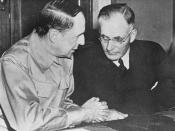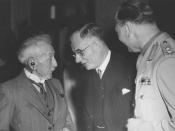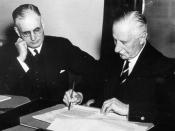Japanese aggression in South-East Asia sparked the Australian government's change in reliance upon Britain to the USA. Was this fear of the Japanese justified and what changes were brought about during the war years?
Japan's grip on South-East Asia was getting stronger throughout 1941. Japanese troops were in Malaya and the Philippines and were getting closer and closer to Australia. The British were unable to provide support to Australia because the European war was using up all their resources. Australia had most of its soldiers in the Middle East, they had lost Britain as a protector and it made them feel very vulnerable. When Singapore fell to the Japanese on February 15, 1942, Australia realised it was alone and defenceless. There was a great fear that Japan was close to invading Australia as its empire was growing. Australian reactions at the time were embodied in an article written by the then Prime Minister, John Curtin�. It showed the realisation of the wavering support of Britain and the need for a stronger power's support. This lead to the switch of reliance from Britain to America. The imminence of a Japanese invasion and made the importance of the domestic war effort ever greater and the recognition of Japan as a real threat.
Japan was a major threat to Australia during the Second World War. Right from the beginning of the war, Australia was concerned about Japan's involvement. Japan was mounting its war campaign in Asia, especially South-East Asia. Nations under Japan's occupation were said to be part of the Greater East Asia Co-prosperity Sphere, which claimed to be liberating colonized nations. This empire expanded from Manchuria to the Dutch East Indies, including China, Indochina, Thailand, and Malaya.� To strengthen the Empire's defences in Asia, Australian soldiers were sent to Malaya...


